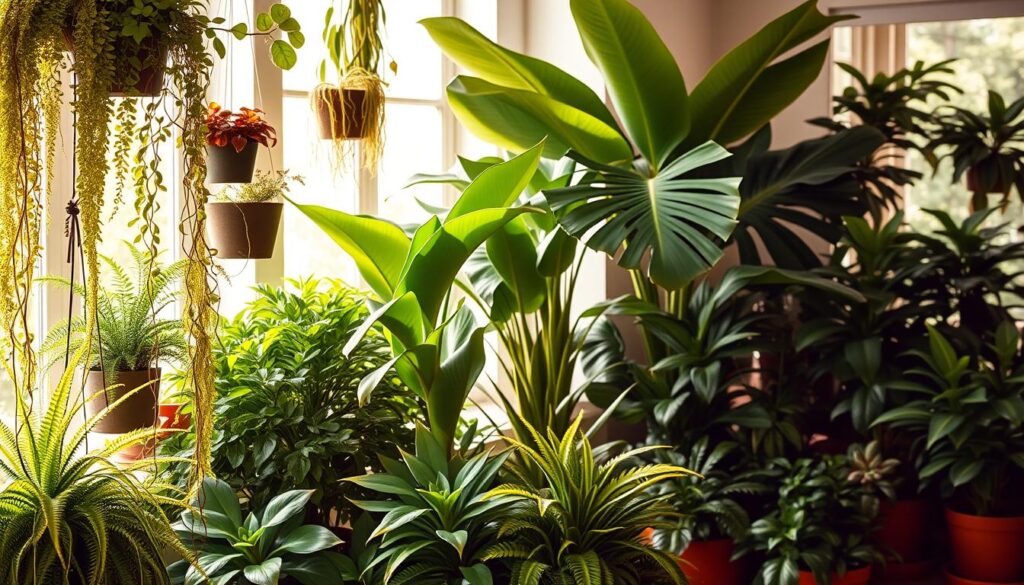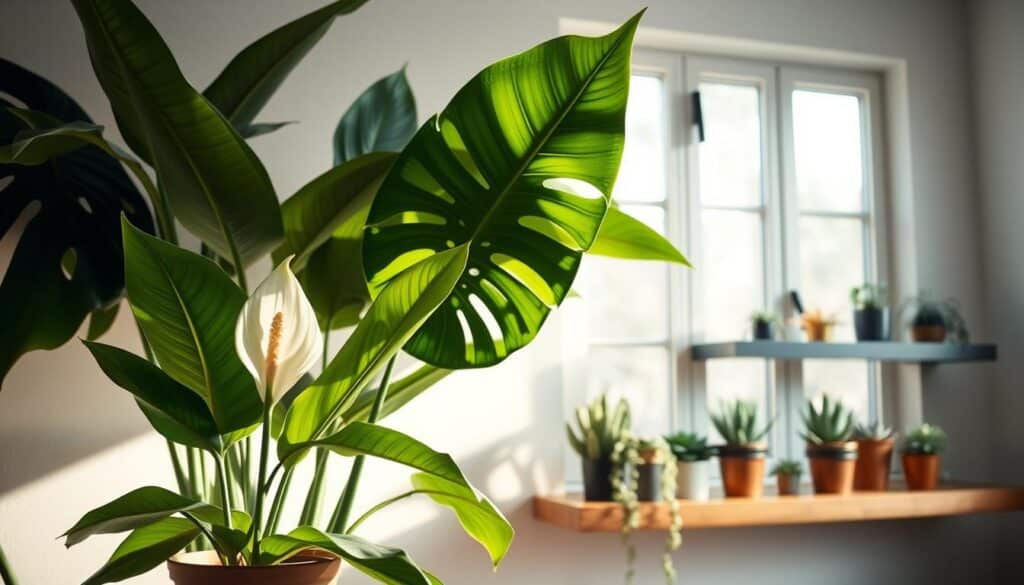Ultimate Guide to Thriving Houseplants

About the Game
Welcome to your all-in-one guide on plant care. This guide will help you grow healthy houseplants in your home. Having plants inside improves the look of your home and is also good for you. We aim to teach both beginners and experienced plant lovers how to care for their green friends.
Learn what your plants need and how to solve common problems. We’ll give you everything you need for great indoor gardening.
Understanding the Benefits of Houseplants
Houseplants make our living spaces better. They help clean the air, making us healthier. Their beauty boosts our mood and well-being. Adding plants to home decor makes everything look nicer and feel calmer.
Anúncios
Improving Indoor Air Quality
Many studies show houseplants can clean indoor air. They remove harmful toxins, like formaldehyde and benzene, through phytoremediation. This helps make our homes healthier places to live.
Boosting Mental Health and Well-Being
Plants have a big positive effect on mental health. They can lessen stress and help us relax. Being around nature lifts our mood and makes us happier. This can make our homes feel more peaceful.
Anúncios
Enhancing Aesthetic Appeal in Home Decor
Plants really brighten up home decor. They bring interesting shapes, colors, and textures. Choosing the right plants makes your space welcoming and nicely designed. A well-decorated home feels more comfortable to live in.

Choosing the Right Houseplants for Your Space
Choosing the right houseplants means thinking about many things. It starts with knowing your space. Light, warmth, and air moisture are key to having healthy plants. Your routine should also match the plants you pick. People with tight schedules might prefer plants that don’t need much care. Meanwhile, those with free time can handle more needy plants. For newbies, some plants are more forgiving and easier to care for.
Assessing Your Environment
First, look at your home’s environment. Check the light in each room, which can be low to bright. Dark spaces? Pothos or snake plants will be happy there. But, if you have sunny spots, succulents and cacti are better choices. Don’t forget to consider room temperature and humidity too.
Evaluating Your Lifestyle
Now, think about your daily life. If you’re always busy, pick plants like ZZ or snake plants. They don’t need much from you. If you have more time, try taking care of delicate plants. They need more of your time but can be very rewarding.
Considering Your Experience Level
Last, consider how much you know about plants. New gardeners? Start with tough plants like spider plants or pothos. They’re strong and handle different environments well. They’re great for beginners taking their first steps into indoor gardening.
Light Requirements for Healthy Houseplants
Knowing how much light your houseplants need is key to their growth. Every plant needs a different amount of light, divided into low, medium, and high. The right light level is crucial for photosynthesis and helps plants grow.
Types of Light: Low, Medium, and High
Plants need different kinds of light:
- Low-light plants, such as pothos and peace lilies, do best in shaded spots.
- Medium-light plants, like spider plants, need bright, indirect sun.
- High-light plants, such as cacti and succulents, must have direct sunlight to grow well.
Light’s intensity and how long it shines affect a plant’s health. Knowing and providing the right light supports strong growth.
Using Artificial Light for Growth
When natural light isn’t enough, artificial light is vital. Grow lights can replace sunlight. These lights offer the same light plants need for photosynthesis, helping them grow. The correct placement and time under these lights give houseplants the energy to flourish.
Watering Techniques: The Key to Plant Health
Proper watering is key to keeping plants healthy. It’s important to know how dry the soil should be for each plant type. Checking the moisture in the soil helps decide when it’s time to water.
Understanding Soil Moisture Levels
Soil moisture is vital for plant health. Most houseplants do well when the top inch of soil dries out before watering again. You can check soil moisture with your finger or a moisture meter. This helps prevent both overwatering and underwatering, which can damage plants. Keeping the right moisture level supports healthy roots and growth.
Best Practices for Avoiding Overwatering and Underwatering
To avoid watering problems, use good watering habits. Too much water can cause root rot, and too little can make leaves wilt. Water with room temperature water and use pots that drain well. This helps keep your plants healthy and happy.
Maintaining Ideal Humidity Levels
Many houseplants come from tropical places where it’s much more humid than in our homes. Keeping indoor humidity between 40-60% helps your plants stay healthy and look vibrant.
To raise humidity inside, you can use a few simple methods:
- Misting plants often helps keep their leaves moist and holds in moisture.
- Room humidifiers work well to keep the air’s moisture level steady.
- Setting plants on pebble-filled trays with water boosts humidity around them as water evaporates.
Putting plants with similar moisture needs together also helps. This creates a mini moist environment for them. It cuts down on the dry air’s stress and supports their growth.
Temperature and Air Circulation for Houseplants
Creating the perfect spot for houseplants means watching their temperature and airflow closely. Most like it between 60-75°F (15-24°C). Knowing this helps keep your indoor garden happy and healthy.
Finding the Optimal Temperature Range
Each houseplant needs its own special temp range. Keeping them in this zone helps them grow strong. It’s key to keep warm-loving plants away from cold spots. Keep them away from heaters too, since too much heat change is bad. Keeping an eye on the temp makes a big difference for your plants.
Importance of Air Circulation
Fresh air is key for keeping plants in top shape. Still air can bring mold, bugs, and sickness. Good airflow gives even moisture and temps. Use fans or place your plants smartly to encourage this. Paying attention to air and temps helps your indoor plants thrive.
Essential Tools for Houseplant Care
Having the right tools is key for plant care. Quality gardening equipment makes houseplant upkeep easier and helps keep them healthy. These items are vital for your plants’ growth and well-being.
Must-Have Gardening Tools
- Pruning Shears: Perfect for shaping plants and removing dead foliage.
- Watering Cans: Utilize a can with a long nozzle to reach deep into pots without spilling.
- Moisture Meters: Measure soil moisture accurately to prevent overwatering or underwatering.
- Quality Potting Mix: Choose organic blends that promote healthy root growth.
Supplies for Pruning and Cleaning
It’s crucial to keep your houseplants clean and trimmed. You’ll need these items:
- Soft brushes for dusting leaves.
- Damp cloths for wiping foliage to ensure proper light absorption.
- Sharp scissors for snipping excess growth or damaged branches.
Fertilization Tips for Thriving Houseplants
Plants inside our homes need the right food to grow healthy and strong. To help them, we need to know what each plant likes. This way, we can make sure they get what they need to show off their best selves.
Understanding Nutrient Needs
Plants inside need certain things to stay healthy. Things like nitrogen, phosphorus, and potassium help them out. If they don’t get these, they might not grow right or look their best. Testing the soil helps us figure out what’s missing. This lets us fix the problem.
When and How to Fertilize
Knowing the right time to feed our plants is key. They mostly need food in spring and summer. Adding liquid food every few weeks is good for them. There’s also food that lasts longer, feeding them over time. Watching how they react helps us make sure we’re doing it right. It stops us from giving them too much.
Pruning and Repotting Houseplants
Maintaining plants well means you need to prune and repot them correctly. Doing these things right makes your plants look good and stay healthy. When you prune, you take off dead or sick leaves. Repotting gives the plant new soil and more room for the roots to grow.
Recognizing When to Prune
It’s key to prune your plants to keep them looking bright. Watch for these signs:
- Dead or yellowing leaves
- Unruly growth patterns
- Diseased or damaged branches
Prune when plants are growing to encourage new leaves and make it look neat. This also allows more air and light to reach the plant.
Guide to Successful Repotting
Plants need repotting when roots come out of the pot or growth slows down. For a good repotting:
- Choose a bigger pot to give the roots space.
- Get a new potting mix for nutrients.
- Water the plant a day before repotting for an easier move.
Identifying and Managing Common Pests and Diseases
Keeping houseplants healthy means managing diseases well. It’s important to watch out for pests like aphids, spider mites, and mealybugs. Catching these pests early can prevent serious damage to plants. And, a good pest control plan can keep your plants vibrant and longer-lived.
Common Houseplant Pests
Houseplants can attract different pests that slow their growth. Some familiar ones are:
- Aphids
- Spider mites
- Mealybugs
- Thrips
Dealing with these pests means knowing how each one affects your plants. Checking your plants often helps you find any problems early on.
Signs of Diseases and How to Manage Them
Knowing disease signs is key to keeping plants healthy. Common symptoms include:
- Yellowing leaves
- Wilting or drooping
- Stunted growth
- Fungal growth on leaves
When you see these signs, act fast. Isolate sick plants, use insecticidal soap or neem oil, and take great care of them. Also, good air flow and correct watering help prevent pests and diseases.
Conclusion
Houseplants change your home’s look and feel for the better. They also improve your health. Learning how to care for your plants is key. The basics like light, water, humidity, and food help your indoor garden grow well. With good care, your plants will look amazing and make your home nicer.
Dealing with pests and diseases is also important to keep your plants healthy. Watching your plants closely and acting fast can stop many problems. Growing houseplants makes your space better and boosts your well-being too.
Knowing the right way to take care of your plants makes everything easier and fun. As you grow more plants, you’ll enjoy it even more. Your indoor garden will bring joy to your life with a little patience and care.
FAQ
What are the benefits of having houseplants indoors?
How do I choose the right houseplant for my living space?
What are the different light requirements for houseplants?
How often should I water my houseplants?
What humidity levels are best for houseplants?
What temperature is ideal for indoor plants?
What tools do I need for effective houseplant care?
How do I properly fertilize my houseplants?
When is the best time to prune my houseplants?
How can I manage common pests and diseases in my houseplants?
Game Details
No
No